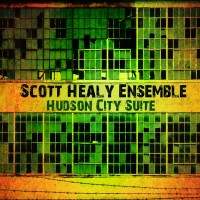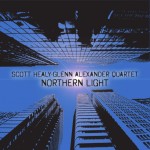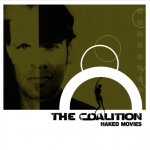Hudson City Suite–Liner Notes by Bill Milkowski
Scott Healy
Hudson City Suite
Who knew that lurking in the back of the bandstand amidst the nightly frolics on TV’s “Conan” show was an accomplished composer capable of such profoundly moving and meaningful music? While Scott Healy is more likely to show the influence of rock ‘n roll piano pioneers Jerry Lee Lewis and Little Richard in his duties as resident keyboardist with the Basic Cable Band on the popular and irreverent TBS talk show, he reveals a deep understanding and appreciation for the sophistication and elegance of maestro Duke Ellington on Hudson City Suite.
More than 20 years in the making, this ambitious large ensemble project alludes to Ellingtonia while incorporating elements common to contemporary jazz and classical music along with bracing solos from a stellar crew of modern jazz improvisers. It swings while studiously avoiding the standard formula of most jazz composers.
“These pieces are definitely more stream-of-consciousness and less worried about form,” says the composer. “Duke Ellington did that, Donald Fagen did that. There have been many contemporary writers who don’t adhere to strict song form. With composing, in jazz, there’s a lot of temptation to play the head, do a series of solos, then play the head again. So you’re constantly going back to the same material. Classical music tells you how to write in linear style, from left to right, more than jazz does. Jazz is very big on chord progression, form and tonality. Contemporary classical is just the opposite. It’s a blank slate, it’s a big empty room.”
And Healy fills that big empty room with a cornucopia of sound that takes listeners on an adventurous ride.
“The genesis of this project started in the late ‘80s when I happened upon Ellington’s ‘The Queen Suite,’” says Healy, referring to Duke’s 1959 masterwork written for Queen Elizabeth II, who was presented with a single pressing of the recording which was not commercially issued during Ellington’s lifetime. “I was listening to one of the tracks called ‘Lightning Bugs and Frogs’, this crazy little tune that I thought was really a gem. It was succinct, it was beautifully written, had a great chord progression and also had this great orchestrational device at the end that was so direct and so powerful. And I thought, ‘I’d like to try and write something like that.’”
His first experiment in that direction resulted in “Prelude,” the serene closing number which bears the unmistakable stamp of Ellington. “I had been doing a lot of progressive and free music at the time — difficult conceptual and abstract jazz that wasn’t formally something that you could latch onto right away – and I was thinking that my writing needed to be more direct. So I wrote this piece and it jumped off the page and worked right away on stage. Everything blended perfectly and also had that direct feel, which I got from Ellington. So I tried to focus on my intent and I pulled it off with that tune. And then I thought, ‘Wow, that was really fun. Let’s make that the prelude to a whole suite of Ellingtonia.’”
Healy eventually decided against making a full-blown classicist tribute to Duke but instead created an original suite in the spirit of Ellingtonia based on his own cinematic impressions of a mythical 19th century town (Hudson City actually existed in post-Civil War New Jersey until 1870, when it became part of Jersey City, where Healy lived during a part of his longstanding tenure on the East Coast before moving to Los Angeles with the Conan show in 2009). Throughout his Hudson City Suite, Healy is mindful of showcasing various small configurations within the larger ensemble. “I love the variety of sound and the way different sounds can be combined with a 10-piece group. For a composer it’s a great vehicle. And since I’m also a player, I like to have the ability to pull out of it a quintet or sextet or piano trio and really stretch out with that rather than maintaining that giant mass of sound. I think a lot of writers actually forget that there are actually small groups within the big band. That’s what really pulls me into working with the large jazz ensemble.”
Writing for four brass (two trumpets, two trombones), three saxes and rhythm section, Healy straddles a few different aesthetics on Hudson City Suite. “I think we’re in a post-idiomatic culture right now,” he says. “I think some jazz composers get caught inside the idiomatic expressions of jazz, where it has to be Basie or Thad Jones or Gil Evans. But more composers these days have reverence for the great jazz composers of the past but also know rock and contemporary classical music. We know Hindemith and we know Steely Dan and we know Bob Brookmeyer, and it all comes together in a faster-paced way so the music is more packed with different experiences.”
Healy’s knack for rich horn voicings is immediately apparent on the modernist, surging opener “Transfer,” which is brimming with active counterpoint behind Tim Hagans’ bristling trumpet solo. Alto saxophonist Kim Richmond briefly engages in some lively call-and-response with Hagans before unleashing a potent solo of his own that shows the perfect combination of old school smarts and modern creativity. Says the composer of this kinetic overture to Hudson City Suite, “I’m trying to move you into the world of Hudson City on this piece. People always talk about Ellington creating his own musical universe with sound. I’m trying to do that same thing with this project.”
“Central Trolley” begins with an evocative horn choir, underscored by Kendall Kay’s supple, lightly swinging brushwork. They proceed for nearly two minutes before bassist Carlos Del Puerto enters with deep-toned, syncopated upright lines and saxophonist Alex Budman soon follows with flowing, lyrical tenor work. Midway through this through-composed piece, the pulse accelerates and Healy turns in an urgently swinging piano solo in a sparse trio setting. Drummer Kay, who effectively freelances throughout the piece, is ultimately turned loose on the kit and he solos in whirlwind fashion to the fade.
“Summit Avenue Conversation” is a pure, unadulterated old school burner in the tradition of the Count Basie and Jimmie Lunceford big bands. Packed with plenty of shout choruses, swaggering unisons and swirling counterpoint, it features pulse-quickening solos from bassist Del Puerto, trombonist Andrew Lippman, trumpeter Hagans and tenor man Budman. Healy concludes this uptempo flag-waver by having the horns play an interesting out-of-time fugue at the tag. It’s a bit of sleight of hand by the composer. As he explains, “One group of horns is in time and one is out of time, so there’s a feeling of randomness to it. But they’ve got a different level of involvement in this tune because they’re playing without a common meter, together. So there’s a lot of listening going on there, and that’s a really cool dynamic in the room when that happens.”
The mysterious “Princess Tongora” was written about a thrift shop painting that Healy found which depicts an exotic Indian princess sitting amidst total chaos, her beauty shining through. The piece unfolds gracefully with a floating rubato feel, though the composer maintains that it is indeed through-composed. “There’s a lot of stuff here that goes over the bar and sounds like it’s rubato or out of time, but it’s very strictly written in time,” says the composer. “Here we have rhythms that repeat but don’t line up and which accentuate each other. Rather than changing meter, I keep the grid steady and then superimpose over that a longer rhythm or cycle. It’s all in time, though, all written out. And then the solos are free form. When you practice writing over the bar or against the meter, you can get more of a free feeling, but the band is not playing free. They’re very much glued to the page. So it’s a really good way to control freedom and control looseness.” Jeff Driskill offers a lyrical and soaring soprano sax solo along the way while Healy, who comps minimally throughout, turns in a gem of a solo in the stripped-down trio setting with bassist Del Puerto and Kay playing sensitive percussive colorist on the kit. The piece resolves to an uplifting theme that has Kay wailing on the kit while the horns underscore his rhythmic bashing with streams of reassuring long tones.
“Interlude” is a brief a cappella showcase for the horns. As Healy explains, “The idea here was to try and create motion and balance without the rhythm section. It’s really cool to write for brass players without rhythm section because they have no safety net. They can’t hide and they also can’t lay back. They have to create the energy, create the rhythm themselves. And they have to do it at the same time. So there’s a lot of inner movement, a lot of counterpoint. And when it happens it becomes a crystal transparent moment when suddenly things lock in and you stop feeling the time and you stop being concerned about it and it just happens.”
“Franklin Steps” is a quirky blues number that has Healy playing behind the beat in classic New Orleans fashion while the horns offer dissonant statements at the outset before settling into a laid back groove. Richmond takes his time on this relaxed, earthy offering before testifying on his alto in a show-stopping solo. He is followed in succession by trumpeters Brian Swartz and Kyle Palmer, each of whom turns in a bold solo. Healy puts the capper on this one with a blues-drenched piano solo, probably the only moment on this album where his Conan and Ellington tendencies might overlap. “It’s got an old gutbucket New Orleans shuffle vibe,” says Healy, “but the harmony is not based on traditional blues chords. I’m not the first person to do that. I actually got that device from Ellington’s ‘Blues in Orbit.’ The chords he uses gives a little bit of a quirky sound but the rest of it is pretty much in the pocket big band writing with lots of counterpoint, lots of lines, lots of riffs.”
“Gaslight” is a lush, harmonically rich number underscored by Bill Wysaske’s brushes. It features the old school plunger stylings of trombonist Lippman, who shows shades of Ellington’s star trombonist Tricky Sam Nanton on his expressive solo. Hagans also offers a lovely, lyrical flugelhorn solo over the Del Puerto’s walking bass, Wysaske’s steadily swinging ride cymbal pulse and Healy’s sparse piano accompaniment. The piece builds to a dynamic crescendo with some swirling counterpoint work from the horns (yet another bit of ambitious writing-arranging by Healy) before settling back into the soothing opening motif with Lippman and Hagans engaging in some mellow conversational interactions until the conclusion. “This tune walks the line between ‘40s harmony and 21st century jazz feel, which is a really interesting combination,” says Healy. “And the voicing is very much like Ellington’s ‘Mood Indigo’ with the clarinet and trombone. Again, it shows a reverence for the past and it’s trying to use some of the motivic material from the other pieces in an interesting way. I wanted to do something more than just play the tune, develop it, take it out, so I gave it more of a through-composed type vibe.”
“Koko on the Boulevard” is another example of a Healy composition that defies the head-solo-solo-head tradition of most jazz writing. Another ambitious through-composed piece that weaves together tones, colors and gestures, it travels from an opening descending line by baritone saxophonist Doug Webb in unison with Healy’s piano and Del Puerto’s bass against the other horns before morphing into a dynamically swinging crescendo that has Webb blowing with impunity over the top. The inventive piece traverses so many stylistic borders that it ends up sounding like Hindemith meets Kenton and Ives at Mingus’ house for lunch. “It’s definitely classically influenced and it breaks rules,” says the composer. “The lead instruments are frequently playing right next to each other and very much different parts. The soprano and the clarinet are purposely written to sound dissonant together. They’re playing the lead melody for half the tune. That’s an idea of a meta melody or a thickened melody, where the melody is wider than just a melodic line. It’s like the melody is echoing with itself and dodging around.”
The intriguing collage closes with the affecting and aforementioned “Prelude,” the tune that inspired this whole new direction in Healy’s writing. While talking to the composer about Hudson City Suite, it was interesting to note how he described many of his tunes in terms of cinematic scenes, whether it’s a guy walking down a peaceful street and then going into a bar where the action is chaotic or someone strolling along the boulevard past gaslight lamps or encountering an inquisitive dog named Koko. It’s as if he’s writing a soundtrack for the movies in his mind. A portend of things to come, perhaps, for this man who wears many hats and is truly deserving of wider recognition after this triumph, which stands as the crowning achievement in Healy’s career to date.
— Bill Milkowski
Bill Milkowski is a contributor to Jazz Times, Jazziz and Downbeat. He is also the author of “JACO: The Extraordinary and Tragic Life of Jaco Pastorius” (Backbeat Books)




